LOOKING FOR DIAMONDS
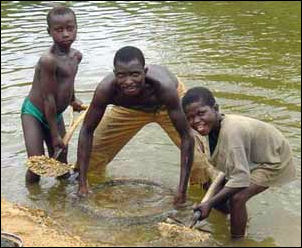
children panning for diamonds
in West Africa Diamond pipes are found almost exclusively in continent-size masses of stone, called cratons, that are generally 1.5 billion years or older. Pipes often contain diamonds but not always enough for profitable mining. Of the 3,000 or so pipes in southern Africa only about 50 or 60 have been worked.
Diamond sources have traditionally been found by panning rivers and looking for diamonds or indicator materials from pipes like garnets, pyrite or chromium dioxide and then going through the laborious process of following the trail backwards to its source. Purple garnets and emerald-green chrome diopsides are a sign that diamonds are present. Locating garnets is often the key to finding diamonds. One diamond prospector told National Geographic, "Diamonds and garnets have nearly the same specific gravity. The garnets fracture more easily and drift with the sand. the diamonds move with the heavier rocks."
Exploring the Namibian coast with a diamond prospector, Bryan Hodgson wrote in National Geographic, "Here and there the beaches were cloaked with scarlet sands, and through a magnifying glass I saw a miniature King's ransom of garnets, a sign that diamonds might lie buried somewhere near."
"We found three skeletons here in 1963, lying side by side, each with a pick-ax hole in the skull," the prospector told Hodgson when they were walking along the Skeleton coast near the Hoanib River. "Obviously they had dug loads of diamond-bearing gravel and brought them here to sift for gems. And obviously there was a forth member of the party who wanted the wealth for himself, and murdered his friends as they slept. But the big mystery to me is where they got the gravel. I haven't seen that particular type on this coast."
Websites and Resources on Gems: All About Gemstones allaboutgemstones.com ; Minerals and Gemstone Kingdom minerals.net ; International Gem Society gemsociety.org ; Wikipedia article Wikipedia ; Gemstones Guide gemstones-guide.com ; Gemological Institute of America gia.edu ; Mineralogy Database webmineral.com ;
Websites and Resources Diamonds: Info-Diamond info-diamond.com ; Diamond glossary and FAQ heart-in-diamond.com ;Diamond Facts diamondfacts.org/about/index ; Diamond Mining and Geology khulsey.com/jewelry/kh_jewelry_diamond_mining ; Diamond Mine mining-technology.com/projects/de_beers ; Costellos.com costellos.com.au/diamonds ; DeeBeers debeers.com/page/home/ ; Wikipedia article Wikipedia ; American Museum of natural History amnh.org/exhibitions/diamonds ;
Book: “The Heartless Stone: A Journey Through the World of Diamonds, Deceit and Desire” by Tom Zoellner.
Mining Diamonds
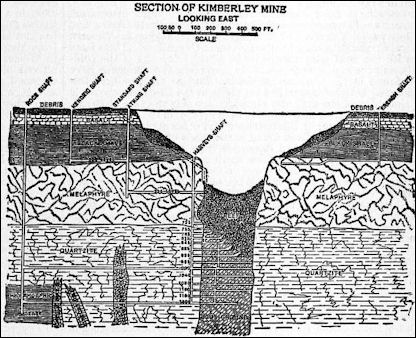
Diamonds are extracted almost exclusively from deep-bore or open-cast mines. Even in the most profitable mines, about five tons of ore generally produces about one carat of rough diamonds. Most of the stones found are industrial stones worth only about two or three dollars a carat. Many mine workers often go for years without seeing a single gen-quality diamond.
Diamond mines typically begin as large pits. Kimberlite is mined with trucks and powerful machines as far down as they can go’sometimes to a point so deep it gets very dark at the bottom of the pit, where the morning and afternoon sun are blocked by the pit walls, and trucks spend half an hour spiraling their way out the mine. If the kimberlite is rich in diamonds the mine goes underground to follow the pipe deep into the earth with shafts that may be over a kilometer deep.
At modern open pit diamond mines, huge trucks load up with tons of ore just like at a iron or copper mines and drop the ore into huge machines that crush, sift and sort out the diamonds in an automated “no hands” operation that reduce the chances of theft. Like most open pit mines, open-pit diamond mines cause erosion, water pollution and habitat loss for wildlife. In places were rivers once ran over kimberlite seams, diamonds can be sifted from the gravel using methods not so different than gold panning.
Workers in underground diamond mines are much better off than their gold mining counterparts. Diamond mines are spacious because a big mass of rock is being mined not a seem. Spaciousness also means the mine is easier to cool and ventilate.
Employees are searched before and after work. At work they have to watch themselves. An employee at one mine told the Washington Post, “You don’t bend down to pick up anything, a stick, a stone, or anything.”
Diamond Mines in South Africa
The Premier Mine in South Africa is where many of the world's largest stones were found including the Culinan. It was worked as an open pit until it reached a depth of 600 feet then became an underground mine. The ratio of diamond to waste rock is 1 to 14,000,000. Many mine workers go their entire 20, 30 year careers without ever seeing a diamond. At depth of 1,100 feet there is a tea room which used to white-jacketed waiters who asked their patrons if they wanted "sugar or lemon." [Source: George Switzer, National Geographic, December 1971 [╿];
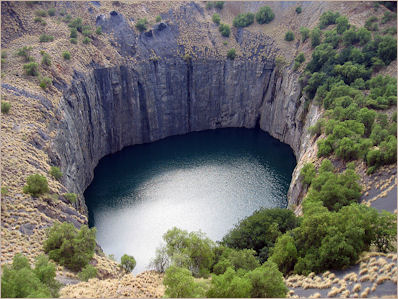
The Big Hole The Premier recovers 15 to 20 walnut-size (100 to 200 carat) stones a year. Half of these are stones worth more than four thousand dollars a carat in the rough. In 1978 another mine was discovered beneath the existed one with perhaps 17 million carats.
Many of South Africa’s famous mines are located in the Kimberley region. Kimberley was catapulted from a piece of semi-ardi desert into a reckless frontier town after the discover of the 21-carat "Eureka" diamond in 1866 and the 83-carat "Star of South Africa" in 1869. Despite the fact that mines are approaching the end of their lives, the name "Kimberley" will always be synonymous with diamonds. In the words of Harry Oppenheimer, "the city will remain the capital of the world's diamonds even when all the mines around it are silent relics like the Big Hole.
Bultfontein Mine is a still operational diamond mine In Kimberley. The Big Hole is said to be the largest hole in the world dug by men without machines. The hole has a circumference of nearly three miles and a diameter of almost a mile. During the 43 years it was operational, starting in 1870, it yielded yearly 6,000 pounds (14.5 million carats, or three shopping carts full) of diamonds from 25 million tons of rock. Some 80 percent of the stones at Consolidated Mine in Kimberley are used for industrial stones, The remaining 20 percent-the gem quality stones — bring 80 percent of the total revenue.╿
Diamond Mines in Botswana
Botswana get more than 60 percent of its export earnings, 65 percent of its government revenues, and 33 percent of its GDP from diamonds. Dbswana, Botswana's diamond mining company, is jointly owned by De Beer Centenary AG (50 percent), the a subsidiary of the South African-based De Beers diamond giant and monopoly, and the Botswana government (50 percent).
There are three major diamond mines in Botswana: Orapa, Lethalkkane and Jwaneng. Diamond mine was discovered at Oropa in 1967 and at Letlhakane and Jwanang several years later. Production at these mines reached its peak in 1991 with 18 million carats, fell to 14 million carts in 1994 and rose the 17.7 million carats in 1996.
Jwaneng, the world's richest diamond mine, is located on the edge of the Botswana Kalahari. Owned by De Beers, Africa, the mine is essentially a big grey hole that follows a kimberlite pipe into the ground. The mine operates around the clock for six days a week.

Botswana minesOrapa is situated on the second largest pipe of diamond bearing rock in the world in terms of surface area. There are 28 other pipes nearby but only one in 200 pipes is profitable to mine. Only four productive ones have been found in Africa this century. [Source: Fred Ward, National Geographic. January 1979 ]
Orapa is located in a part of the Kalahari Desert where temperatures often exceed 120̊F and blown sand causes respiratory ailments similar to those seen in workers in smokestack industrial towns. To find the site took 12 years of intensive searching.
In the mid 1990s, about $400 million was invested at Oropa to double the production capacity from 6 million to 12 million carats. The new facility, open in 2000, boasts a CARP (completely automated recovery plant) and a FISH (full integrated sort house), which will almost totally eliminate the risk of theft.
To prevent thefts diamonds at the Orapa mine are sorted and handled by special gloves built into sealed boxes, which prevents the workers from actually touching the gems. Even then workers are watched over by a guard and monitored by video cameras. The sorters sort out industrial diamonds from gem quality stones.
Diamond Mines In Namibia
Namibia embraces the richest diamond producing region in the world. Nearly one fifth of the world's gem quality diamonds come from Sperrgebiet — the forbidden region — along the Atlantic coast near Orangemund, where diamonds carried down the Vaal and Orange River from the Kimberly region of South Africa and Lesotho over the millennia have been sorted by the ocean currents and deposited on the beaches of southern Namibia. Most of the diamonds were created about 3 billion year ago and were brought to earth by volcanic eruptions about 100 million years ago. [Sources: Fred Ward, National Geographic, January 1979; Donald G. McNeil, New York Times, April 27, 1988]
The South African De Beers company bought the sixty miles stretch of Skeleton Coast desert around Orangemund in the 1920s. In the 1980s, Orangemund brought in almost a quarter of De Beers annual worldwide profits of US$800 million on US$2.5 billion in sales.
Since 1994, the Namibian government has shared ownership of the mine with De Beers as part of an operation called Namdeb. The diamonds taken from the Oranjemund mind includes valuable pink and chartreuse fancies.
The mines take up only 3 percent of the forbidden zone. The rest is a security buffer. The 1991 the output of mine was $385 million, 20 percent of the GNP of Namibia. At that time company payments constitute 40 percent of Namibia’s revenues. Once they constituted 90 of Namibia's revenues.
The Sperrgebiet region is mined by Ernest Oppenheimer's Consolidated Diamond Mines (CDM) who won an exclusive concession starting in 1920. CDM searches for new mines with mineral survey on land and prospecting vessels in the sea. De Beers operated CDM accounts for 65 percent of total mining revenues. Reserves along coasts ran out in the early 2000s, at time CDM shifted to offshore mining.
Diamond Mining in Namibia
The mine at Oranjemind is essentially one of the world's largest earth moving operations. The diamonds are found in the alluvial soils that are between 50 and 85 feet below the surface underneath a layer of sand. Huge piles of overburden are deposited in big piles on the beach.
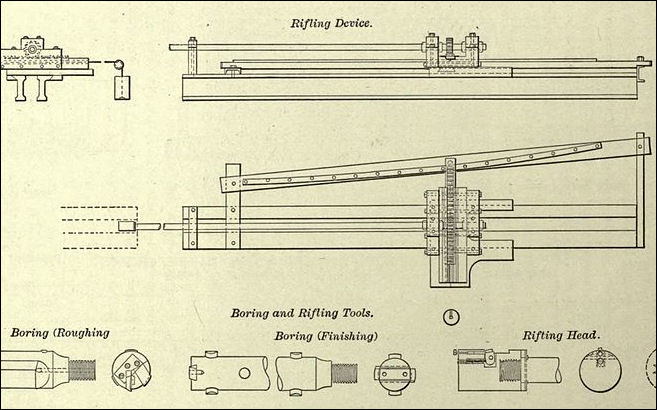
Old diamond mining machine
Machines and crews work around the clock to reach and extract the diamonds. Bulldozers push the ocean back 200 yards and giant bucket wheels dig off 50 feet of sands to reach the -six-foot-thick layer of gravel. Huge brush machines mounted front loaders then scrape the gravel off the bedrock.
Treatment plants screen the diamond-laden gravel, spewing great hills of tailings. A hundred million pounds of sand and gravel is sifted through to come up with one pound of gems. In one year CDM sifts through as much as 57 million tons of sand to recover 1.56 million carats of diamonds.
Diamonds are also found using the "paddock" mining, in which dams are built 300 yards into the ocean. Water and sand are pumped out and diamonds mined at fifty feet below sea level.
Presently mining is only done near Oranjemund, although abandoned mining sites and equipment lie scattered across the 54,861-square miles Restricted Diamond Area, where mining has gone on for over 60 years. It is estimated that Orangemund will be productive for another 25 years. Environmentalists have criticized the mines extraction methods.
Sweepers and Diamond Workers in Namibia
Behind the machines are with giant vacuum cleaners that suck up the dirt and gravel the other machines can’t get. In the old days bedrock crews of 24 men with whisk brooms and shovels carefully went through all the loose rocks located within the cracks and crevices of the bedrock. Often the best stones are lodged in crevasses. When a gem was found it was given to the crew's headman who placed the stone in a pouch. A single tidal pool one yard in diameter once yielded 2,700 diamonds weighing 3,000 carats.
The diamond miners work under about the same conditions as their counterparts in South Africa. Workers are mostly black men who sign six, nine or twelve month contracts and live on a compound until their contract expires. Room and board are free which means they can take home most of their US$170 (1979) salary. When they leave the compound after their contract expires all their belongings are scanned by a powerful X-ray machine and their bodies are thoroughly searched.
At one time crews were payed bonuses for the number of gems they found. Now their bonuses hinge on the amount of rock excavated and the area covered. The workers simply sweep up the rock and later it is examined at the plant.
Security at the Namibia Mine
Sorters never touch the diamonds. The diamonds are in special glass chambers and the sorters work outside the chamber using special gloved hands. The gems are dropped into vacuum tubes that suck them into a vault.
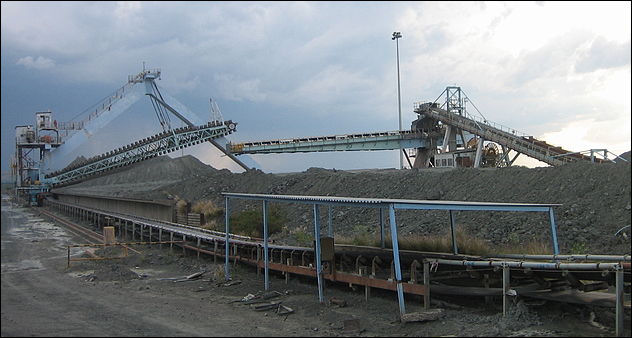
Modern methods used at the mine where the Cullinan was found
The CDM mine in Namibia is one of the few diamond mines where workers (the sweepers) actually lay their hand on the diamonds. As part of the mine's securit workers at the end of their shift are ushered into a corridor surrounded by glass and monitored by video cameras. Security guards carefully pick through the workers clothes and give them random full body X-ray. So workers don't get radiation poisoning they carry cards with their X-ray history. The workers go through a machine that flashes light but the workers can’t tell whether they are being X-rayed or not.
If the worker acts suspiciously he is subjected to a search with a fluoroscope. If everything appears okay an exit door opens and the worker is free to go.
Orangemund and the road around on it is not shown on most maps. Outsiders who enter the area need a special permit, which requires showing that they have no criminal record. Watching over the fences that extend around periphery of the mining area are heavily armed guards and dogs.
Worker who find diamonds on the ground are given 70 percent of its value. No miner turned one in between 1983 and 1998.
Possession of an uncut diamond can bring a 15 year jail term. Miners have been found with diamonds in the ears, noses and other orifices. People have been shot trying the scale the mine’s fences. One worker found a homing pigeon with small pouch with 123 diamonds in it. He turned in the pouch and was given a substantial bonus. Later four men were arrested with $6,000 worth of uncut diamond and charged with using pigeons for diamond smuggling.
Diamond Mines in Australia
Australia's trillion-stone diamond fields have the world's highest yields in terms of number of carats. Argyle Field in West Australia was the world's richest diamond producing area. In 1983 the field yielded over 6.2 million carats. Few of the diamonds, however, were of gem quality.∑
At its peak the Argyl Diamond Mine in Eastern Kimberley produced 34 million carats of diamonds a year — more than a third of the world production. Even though only five percent are gem quality the mines produce rare pink, champagne, cognac and apricot hued diamonds that can sell for 50 times the price of normal white diamonds. Also coming from Western Australia are two thirds of Australia's gold.☼
Life at these mines has its hardships. At Argly workers are so isolated they often fly 1,400 miles to Perth for weekends. At Broken Hill it is not unusual for extended families to lose two or three of their members in the mines.↔
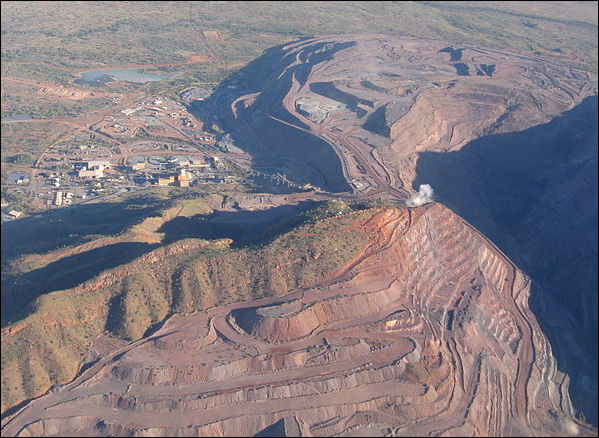
Argyle Diamond Mine in Australia
Shift from Mined and Blood Diamonds to “Cultured” Lab-Produced Diamonds?
Luxury consumers are now coming around to man-made diamonds, because they are conflict-free and more affordable than mined diamonds. Thanks to investigative journalism, the public has grown aware of “blood diamonds”, whose sales fund conflict. Many consumers have lost faith in the mined-diamond industry that marketed their gems as “conflict-free” and “ethical” for decades, that were in fact used to fund conflict. [Source: Time; CNN; The Guardian; CNBC; Diamond Facts; Synthetic Verus Real Diamonds and the Conflict Diamond debate heart-in-diamond.com
Cultured diamonds are developed in a controlled setting and have a smaller carbon footprint than mined diamonds. The Congo is a leading exporter of diamonds worldwide. Due to widespread lawlessness, regulation of the diamond industry in the Congo is difficult. Illegal export of Diamonds from the congo is a common practice according to experts. The diamond-mining industry in the Congo has fueled many coups and wars and has left many of the country’s inhabitants desperate and poor.
Extensive rock and dirt is displaced to extract diamonds from the Earth. Entire ecosystems have been destroyed due to the massive land disturbances. In addition, other challenges for diamond-mining include: 1) Energy use and emissions. 2) Use of water, 3)Waste and recycling and 4) Biodiversity.
Image Sources: Wikimedia Commons
Text Sources: Mostly National Geographic articles. Also New York Times, Washington Post, Los Angeles Times, Wikipedia, The Independent, Times of London, The New Yorker, Time, Newsweek, Reuters, AP, AFP, Lonely Planet Guides, Compton’s Encyclopedia and various books and other publications.
Last updated May 2018
